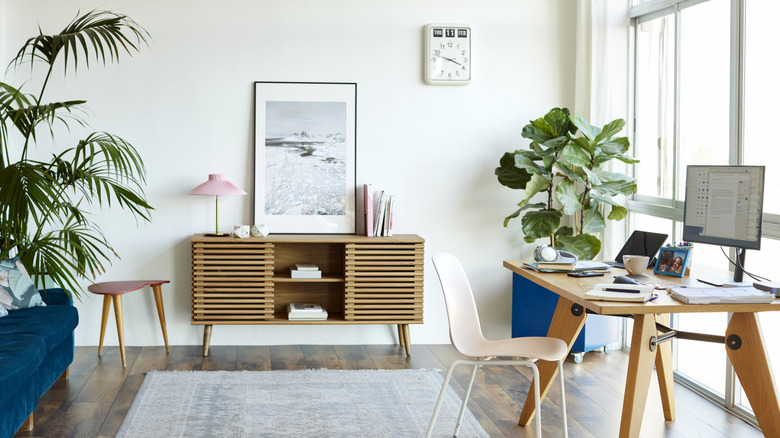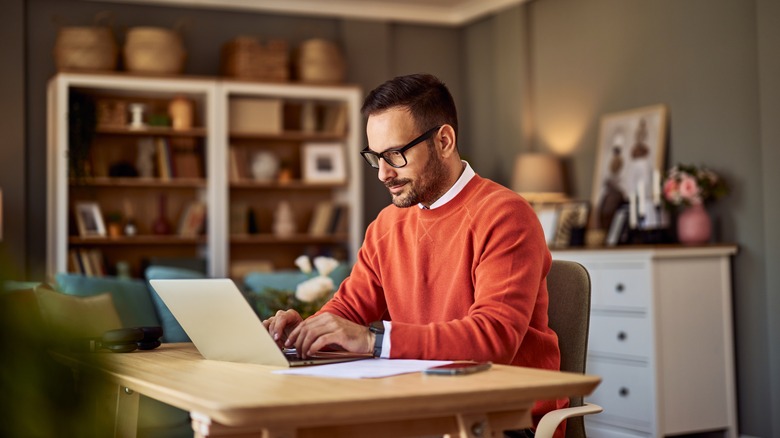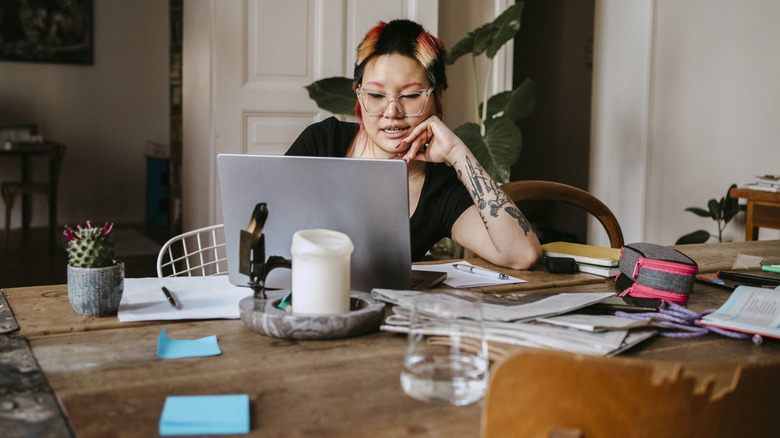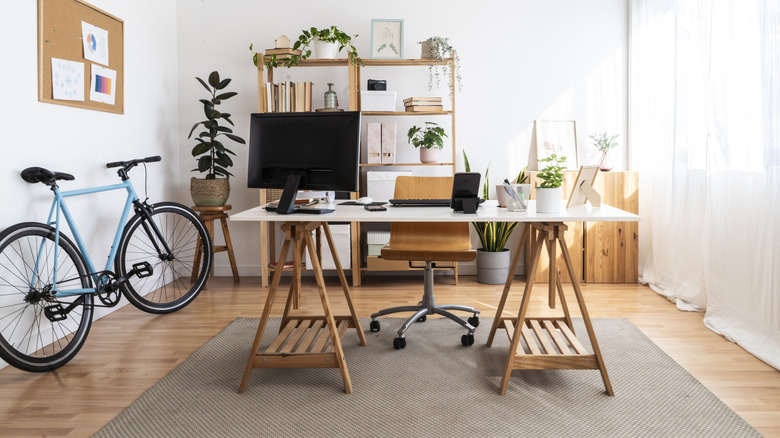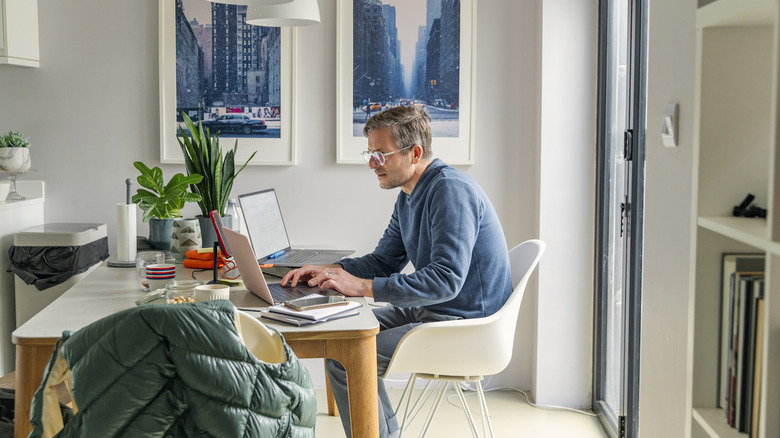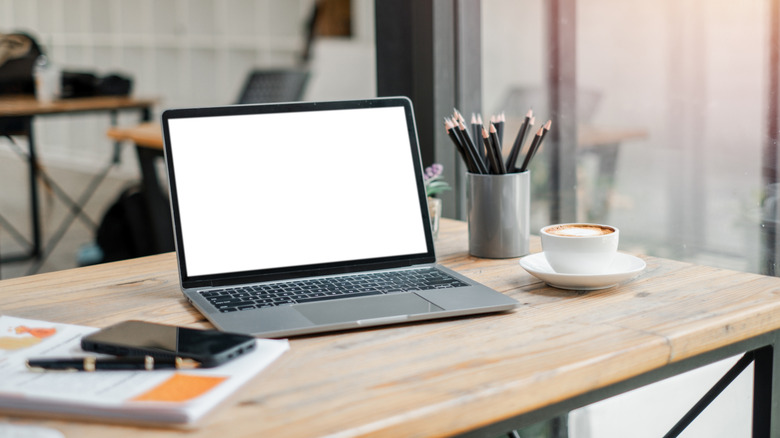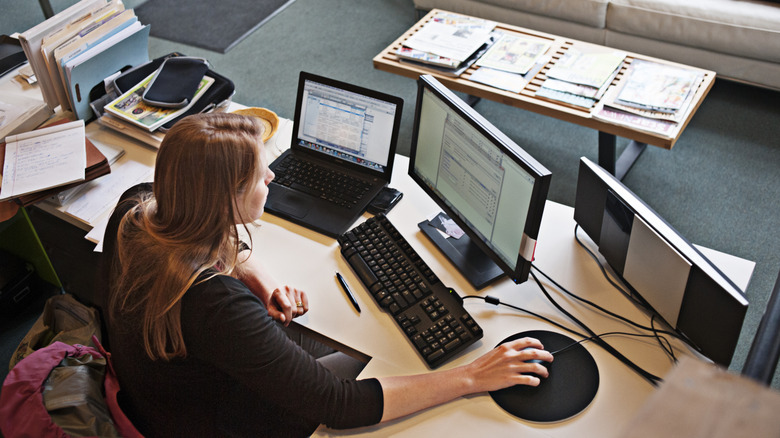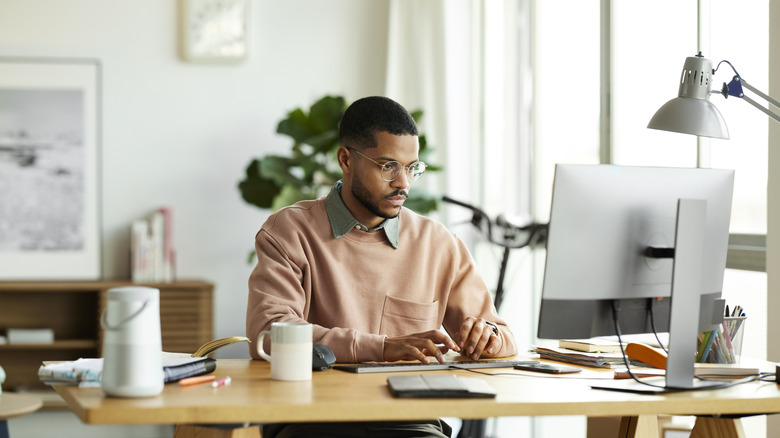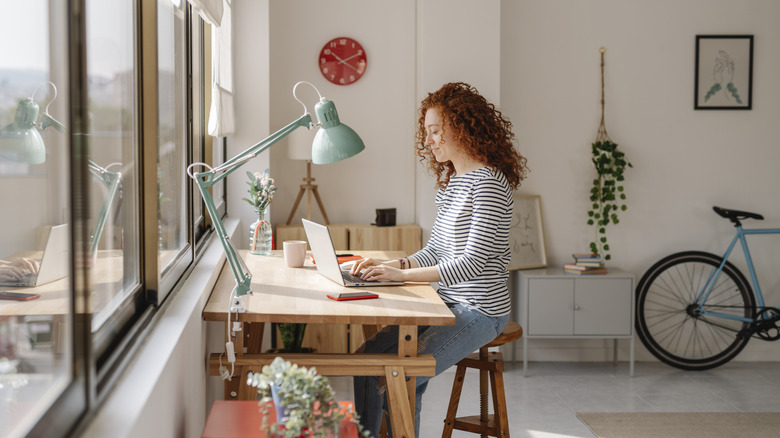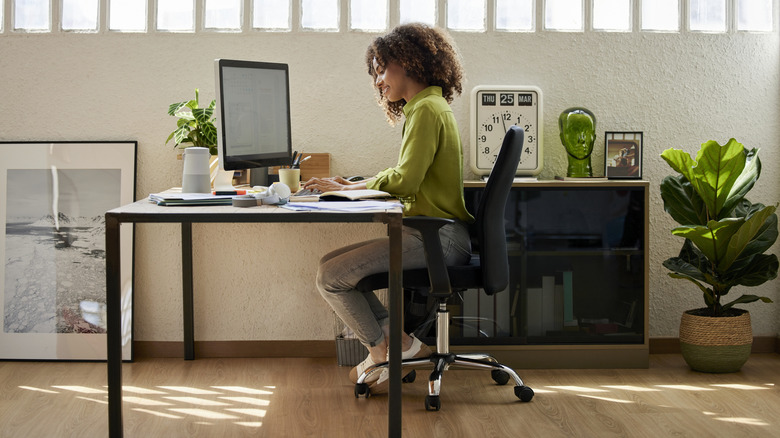9 Home Office Design Mistakes That Are Ruining Your Workflow
We may receive a commission on purchases made from links.
Whether dinosaur pajamas have replaced your traditional work clothes or you're striking out on your own, having a dedicated work area is crucial to minimize distractions and improve your efficiency. But how do you go about designing a functional space that inspires creativity and motivates you? After all, there's a lot to consider, including the room's layout, installed lighting fixtures, available storage solutions, your furniture choices, and personalized touches. And messing up even one of the elements can quickly take your home office from a productive work environment to a dull and uninspiring space. Certain mistakes might even be detrimental to your health.
For instance, forcing yourself to work in a dimly lit room will hamper your productivity and cause eye strain. Similarly, using a chair that isn't compatible with your desk and is uncomfortable to sit in will lead to body aches and make it difficult for you to focus. Not optimizing the space to suit your unique needs is another mistake that'll lower your engagement levels. Likewise, an office void of personalized touches won't foster a sense of belonging. To help you avoid these common blunders, we spoke exclusively to three experts and asked them to highlight the secrets to designing an inviting home office. Looking to carve out a small working area for yourself or give your existing home office a makeover? Here are nine common mistakes that can ruin your workflow and ways you can overcome them.
Poor lighting will lower your productivity levels
Lighting is one of the most important aspects of a work environment. Unfortunately, it's also one of the most overlooked. A 2016 study by the American Society of Interior Design shows that 68% of employees criticize their office's lighting. This is because good lighting conditions can mean the difference between tired, itchy eyes and enhanced concentration. During an exclusive House Digest interview, Effy Terry, Certified Professional Organizer in Chronic Disorganization (CPO-CD) and founder of Organize That (who also trained with Marie Kondo and achieved Certified Master Consultant status) echoes similar sentiments, saying, "Insufficient or harsh lighting can lead to eye strain and fatigue, reducing productivity."
So, improving the lighting conditions in your home office is vital. However, adding general lighting isn't enough. Take a layered approach and combine task, ambient, and accent lighting to design a well-lit space. Start by segregating the room into segments to recognize the type of lighting you want in a particular area. Then, explore a few beautiful home office lighting ideas that will maximize productivity. Terry suggests, "Use natural light by positioning workstations near windows." Besides being a free light source, the daylight can help improve your productivity (as evidenced by a 2018 research article published in the Ergonomics International Journal). Terry recommends including "adjustable task lighting to help to create a bright, comfortable workspace. You can also install dimmable lights to allow control over brightness based on individual needs." Besides pinpointing any task-specific lighting requirements, you'll also want to consider the placement of your desk and light fixtures to avoid headache-inducing glare.
A cluttered desk will split your focus and distract you from tasks
If your job performance has been suffering lately and you're finding it difficult to focus on projects, your messy desk might be to blame. Terry says, "A cluttered desk can create distractions and make it hard to focus on tasks." It's difficult for your brain to concentrate on a project when there's a mountain of paperwork, dirty cups and coffee mugs, 'lost' receipts, sticky notes, and file folders demanding your attention. That's not all. Desk clutter can negatively impact your mental health, promote indecision, and induce stress and anxiety. Worse, you might spend hours looking for a required document if there's no method to your madness.
To help you remain focused, Terry walks through some of the best ways to tidy up your office desk, saying, "Create an organizing system with designated spaces for supplies and papers to keep the workspace tidy," and recommending that you define zones for like objects. "Assign specific places for frequently used items to ensure they're always returned to the same spot. For example a shipping zone and a stationery zone," she elaborates. Another important suggestion is to move any clutter off your desk. Terry recommends using transparent bins which you can see into, making it easier to locate the stored items. She also advises labeling all your bins, drawers, and shelves. This will create a system that's simple to follow and user-friendly for anybody else who needs to access items in the home office. Also, don't just rely on horizontal storage areas. "You can also use your vertical space. Install shelves, hooks, or pegboards to maximize storage without cluttering the floor," Terry explains.
Terry's number one tip for individuals with ADHD is to make use of visual cues. She elaborates, "Out of sight is often out of mind for people with ADHD, so keeping things visible can help you stay organized and on track." Again, clear bins can be an invaluable organizing tool, perfect for providing visual cues. Terry also recommends open shelves as they allow you to see what's stored on them in one glance.
Uncomfortable furniture will tank your productivity and impact your health
Sitting on your poorly designed desk chair and staring at your computer screen for hours on end might be a regular Tuesday for you. But it's another long and painful day for your body. Terry mentions, "Sitting in an uncomfortable chair can lead to physical discomfort and decreased concentration." A sore neck, back, and shoulders are the most probable symptoms of a bad posture. Pain may also extend to your elbows, wrists, and hands. Headaches and eye fatigue can be an issue, especially if your screen is badly positioned. You may also start feeling exhausted earlier than usual due to restricted blood circulation. Not feeling your best physically will leave you drained mentally, tanking your productivity.
According to Terry, "Ergonomic furniture supports proper posture and promotes comfort during long hours of work." She proposes, "Invest in adjustable chairs with lumbar support to maintain proper posture. Look for desks with adjustable heights (sit-stand desks) to alternate between sitting/standing, and look into footrests to support legs, which will reduce strain for shorter individuals." Besides offering ergonomic advantages, the right desk chair can add good feng shui to your home office. Terry shares another ADHD-specific tip, saying, "Incorporate wobble stools or balance ball chairs for movement-friendly seating, which can help individuals with ADHD stay engaged."
Finally, the organizer reveals a secret for staying at her desk when she lacks motivation. She shares, "Keeping a foot massager under my desk has been a game-changer. On days when I'm not feeling productive, it helps me feel more comfortable and encourages me to stay at my desk."
An inefficient home office layout will negatively impact your job performance
Plopping down your desk and chair wherever you find space or in front of the most scenic window might seem like a good decision initially. However, getting up constantly to grab a few sticky notes or turn on the power switch for your laptop will interrupt your workflow, impacting your job performance over time. Terry mentions, "A poorly arranged office can cause unnecessary movement and interruptions, affecting efficiency." Moreover, being stuck with the same office layout day in, day out may cramp your working style and hamper creativity.
So, be deliberate regarding your home office's layout and design a space that fits in with your unique working style and job demands. Terry shares a simple tip, recommending that you "arrange [your] workspace to keep essential items within arm's reach, which minimizes the need to get up frequently." To ensure you stay focused, she advises, "Position the desk to face the wall or a quiet area, minimizing distractions from high-traffic spaces or windows." If you're having trouble planning the layout, Terry's rule of thumb is to "arrange furniture to create a logical flow, with the desk as the central hub and storage or filing systems within a few steps."
Looking for two-desk home office design tips that maximize space and functionality? Terry suggests, "Use an L-shaped or U-shaped desk formation with defined zones for computer work, writing, and other tasks. Place frequently used equipment, like printers or file organizers, on a nearby shelf or a side table for easy access." She shares another important WFH tip, saying, "Set up a dedicated meeting or collaboration zone if your work involves frequent virtual or in-person discussions."
Lack of personalization in your home office can decrease motivation
Imagine having to occupy a work desk without your personal effects. Now, imagine some select memorabilia on the desk's surface once you start calling it yours. Which of the two scenarios do you think would be more conducive to your job satisfaction and engagement? While it's a matter of personal opinion, a research article published in the Journal of Environmental Psychology highlights a positive relationship between worker well-being and personalization. Explaining the reasoning behind this, Terry expounds, "A sterile environment can feel uninspiring, leading to decreased motivation." Even though you'll be in your haven, adding personal touches to your work environment is necessary to establish a productive office at home. This is because you'll probably feel more comfortable inhabiting the space and working towards your dreams.
Personalizing your home office can be as simple as "incorporating personal touches, like artwork or plants, to create an inviting and motivating atmosphere," says Terry. To make the room more enticing and add a touch of warmth, she suggests including "family photos, mementos, or items that have sentimental value to create a connection to your space." Not the sentimental type? Terry has a biophilic alternative for you. She advises, "Use plants to add color, improve air quality, and create a calming environment."
Individuals with a brown thumb can stick with low-maintenance options, such as succulents or snake plants. Alternatively, "you can also use colorful decor, such as throw pillows, area rugs, or desk accessories, to break up monotony and add energy to the space. This is a low-cost way to introduce novelty season to season. If you like scent, aromatherapy, like lavender or citrus, can create a relaxing or invigorating environment, depending on your preference," Terry concludes.
Your home office design ignores ADHD needs
If you (or your partner) identify as a neurodivergent individual with ADHD, it's important to design a home office that helps you focus on your projects and isn't too distracting. Terry, a certified ADHD coach, suggests you incorporate visual organization tools to make it easier to concentrate. She elaborates, "Using visual organization tools, such as color-coded folders, whiteboards, or labeled storage, can support focus and reduce distractions." Not only will this make your space feel ultra-organized, but it can also preserve mental energy. "Visual cues can serve as reminders for tasks and priorities, making it easier to stay on track. This strategy minimizes the cognitive load of remembering what needs to be done and helps create a more organized workspace," Terry clarifies.
Unsure how to go about adding these visual cues to your office? Terry suggests, "Designate a visible area in your home office for a whiteboard or bulletin board where you can jot down tasks, deadlines, and perhaps motivational quotes (I use fun, colorful magnets with motivational quotes)." She outlines how to turn tasks fun to get them done, saying, "Use colors to differentiate between types of tasks or projects. This not only keeps your workspace organized but also adds a visual element that can be fun, engaging, and motivating." Incorporate these visual cues into a low- or high-stimulation environment, depending on the approach you're more comfortable with. If you get distracted easily, keep your desk mess-free, ensure the room isn't too noisy, and opt for minimalist decor. However, if you thrive in chaos, go bold with the decor theme, embrace a little (curated) clutter, and play your favorite tunes aloud.
You're not facing something motivating
It's easy to click-clack your PC's keyboard all day long when you're in your zone and your focus mode is turned on. But what do you do on days when all you want is to curl into a tight ball, find gorgeous mountain homes for rent on Airbnb, stream the latest drama, and eat ice cream? Such days can be especially challenging, and this is why you should always face something motivating. It'll help you remember your purpose — the reasons why you need to tolerate your Karen-like boss for another few months or accommodate the confused client's random requests.
But it doesn't have to be anything billboard-worthy. In her House Digest exclusive interview, Nikki Klugh, an award-winning interior designer and the principal designer of Nikki Klugh Design Group, Inc., says, "Your eyeline should look towards items that motivate you. This can be photos of your family, your favorite quotes, artwork showcasing places you want to travel to — anything that shows your WHY and keeps you productive." Klugh has 20 years of design experience under her belt, so we'll gladly take her tip for staying focused. The reasons you're working for today should be clear so you don't lose sight of your goals — big or small — and can convince your brain to come online and power through.
Your desk faces a high-traffic area or doorway
Positioning your desk against a window has several benefits, such as keeping your creative juices flowing and connecting with nature. Alas, a stimulating view can also be a source of distractions and pull your attention elsewhere. Seriously, who'd want to work on a project report when you can watch butterflies romance the flowers in your backyard? Similarly, facing an open door can draw your attention to the happenings around your house, making it difficult for you to concentrate. Agreeing with these desk-positioning mistakes, Malak Bellajdel, the in-house interior design expert at MetalPlex and one of Interior Design Magazine's 30 Under 30 Top Designers in 2023, says in her exclusive House Digest interview, "One mistake that really affects focus is placing your desk facing a high-traffic area or doorway. Every [movement] in your peripheral vision will grab your attention and shift your brain's focus."
So, to avoid trading your focus and zeal to work for the view outside, move your desk to the window's side. Since you'll have to put in more effort to glance toward the opening, it'll be easier for you to focus. Plus, you can take advantage of the natural light streaming in without worrying about glare. However, don't put your back to the door if you don't want to feel like people could creep up on you. Bellajdel recommends, "Position your desk so you can see the door without being in direct line with it. This gives you control over your attention while avoiding the anxiety of having your back towards the entrance." The commanding position will also invite good vibes in your home office per feng shui principles.
Having the wrong desk height for your chair
Trying your best to reach the high desk from your seated position might've looked cute when you were a toddler. As an adult, it'd look absurd to sit at a desk that's too low or high for your chair. Plus, maintaining an incorrect posture will make your neck and back ache. Worse, you'd be spending a significant amount of your day contorting your body to fit the desk instead of working. Highlighting the gravity of the situation, Bellajdel elaborates, "Having the wrong desk height for your chair is particularly problematic for creative work. When your arms aren't properly supported, you'll unconsciously tense your shoulders and neck. This can lead to fatigue that will cut your productivity short."
Considering this, it's vital to choose a desk that's compatible with your work chair. Remember, the same-size-fits-all approach doesn't work here since a harmonious arrangement will depend on your height. So, experiment a little before finalizing a design. The ideal fit will let your feet rest comfortably on the ground, with your knees at right angles. The same goes for your elbows wherein your forearms are at the same level as the desk. Moreover, "You want to ensure your elbows are at roughly 90 degrees when typing, with your monitor at eye level," adds Bellajdel. She also mentions that "an adjustable desk or monitor is worth the investment here." But if you don't have enough liquid cash to get a new desk, an adjustable footrest, like Mind Reader's Height Adjustable Foot Rest, is a great alternative if your feet aren't resting comfortably on the floor. On the other hand, table risers, like Utopia Bedding's Adjustable Furniture Risers, can be an option for raising a short desk.
